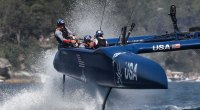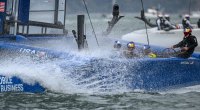Success at SailGP depends on teamwork and communication. As a one-design class, all 10 teams use the same gear for each race and have access to each other's team data. Capable of speeds of up to 60mph, the F50 catamaran is designed to put performance and results right in the hands of the elite athletes on board, such as; B. Jimmy Spithill.
As skipper of the United States SailGP Team, Jimmy Spithill is responsible for knowing the logistics of the event should the start and finish points change, communicating with his onboard crew and making decisions about where to go on the track. Spithill's training, while easy to explain, is anything but. US SailGP Team Athletic Performance Director Craig McFarlane is tasked with ensuring that every member of the team is at their best on race day.
Below is exactly what one of Spithill's sessions entails. Also, don't forget to hydrate, he says.
Courtesy of SailGP
Jimmy Spithill's SailGP Strength & HIIT Session Flow
- Mobility & Activation (10 min.)
- Agility and reaction exercises (10 min.)
- Structural Strength (15 mins)
- HIIT / MetCon (20-30 mins)
- Recovery (5-10 mins)
Mobility + activation session
US SailGP Team Athletic Performance Director Craig McFarlane says the key concept here is to prepare Jimmy Spithill for the movements and muscle groups he will be using in the session, especially early on.
mobility
- spine: MacFarlane focuses on spinal mobility in all areas: flexion, extension and rotation. This relieves a lot of muscular tension and makes the musculoskeletal system more flexible.
- hips: Various hip openers and yoga-derived poses are performed each day. The hip region is the driving force for every sport and the center of strength and stability. Jimmy, like most riders on an F50, has tight hips - both back and front - from constantly standing and stabilizing in such a dynamic and aggressive environment to allow the upper limbs to freely perform global movements (steering) and finer complex sensory movements can (button function on the steering wheel).
- Shoulders: Maintaining shoulder mobility and flexibility is very injury preventive and mitigates any downward tendinopathy drivers may experience with their elbows/forearms from constantly gripping the wheel.
activation
There's a posterior chain bias - we're talking glutes, hamstrings, lower back. Spithill's sailing position involves standing. That's the position he lives in on the F50, so we need to make the activation moves and drills translatable.
Agility and reaction exercises
Some cognitive qualities that F50 drivers need to work on are: focus, concentration, reaction time and footwork.
“I like waking up the nervous system and perception of higher functions earlier in the session. I will be using various close range reactive mobility exercises using all the sensory elements such as vision, hearing and touch.
I start with a combination of jump rope work and a band-resisted fast-leg turnover drill. I'll wrap a resistance band around my waist and I'll provide an anchor and resistance from behind. The athlete sprints in place for a maximum of five seconds, then jogs easily for five seconds, three times for two laps. These low-resistance leg turnover exercises help all F50 athletes cross the platform more deliberately and quickly between maneuvers to perform their position sailing function more quickly.
Then there are footwork and agility drills where he responds to a cue for multiple sensory training - starting with a visual cue and then with multiple verbal responses throughout the drill or task. These exercises become increasingly complex.
 Courtesy of SailGP
Courtesy of SailGP
structural strength
Strength is both about preventing injury and building resilience. A driver like Spithill gets thrown around just like the grinders on the F50. Strength equals stability equals performance!
There is a big focus on asymmetric and midline core strength training that challenges all structural systems. The strength component includes an important lower-body movement with a complementary lower-body add-on exercise for three to four sets with a short rest.
MacFarlane will take advantage of “dead time” during the rest period between sets and incorporate injury prevention measures specifically tailored to the needs of the athlete or the position. Shoulder stability and rotator cuff strengthening are a must for riders.
1a. Single leg kettlebell deadlift as a key move
This helps:
-
- Posterior chain: glutes, hamstrings, back.
- Posterior Loops: Fascia that runs from and diagonally down and keeps the skeletal system stable when it is unbalanced.
- core
- stability
1b. Single scale with side wall ball ejection
This helps:
-
- co-contraction
- balance
- hand-eye coordination
- core
I'm going to follow the lower body couplet with a short upper body strength couplet that will have push + pull. In order to get maximum benefit and incentive, it is important that drivers also lift heavy and challenging loads.
This upper will consist of three shorter sets with very short rests (about 60 seconds) between sets:
2a. One-arm standing cable or band press: Walk heavy for six reps.
This helps:
-
- Heavy weight will challenge all structural systems
- Standing engages the core to remain stable and square, avoiding rotational forces
- Ability to anchor and stabilize from the hips down while the upper moves dynamically under high-impact loads. An extreme simulation of F50 stress
- thrust
- tension
2 B. One Arm Kettlebell Bentover Row ( Support): Heavy for 8 reps.
This helps:
-
- back strength.
- Rear chain under an isometric (non-moving) load.
- core
- stability
Standing in a stable joint position with a wide, stable base, pull the kettlebell to the side of your torso and keep your elbow high and close to your side.
Remember to use "dead time" during rest time between sets. This is also good for low-level physical training. Most riders like to work on grip strength or the finer grip strength. So different ways of carrying that challenge the grip.
 Courtesy of SailGP
Courtesy of SailGP
Cardio Block – HIIT/ MetCon
These cardio blocks are metabolically very dense - which involves high energy expenditure and targets multiple energy capacities, skills and sensory elements.
Boxing would be one of the biggest hits for your cardio buck for any SailGP F50 rider. If you look at the F50 crossover perks, you can understand why Jimmy Spithill not only embraced this art, but took it to another level.
Drivers must work on:
- focus
- concentration
- reaction time
Boxing builds skill and technique by getting the hips and feet moving and covering all punch variations and dodges. Skill complexity will quickly progress as you have to memorize multiple hit and move combinations while avoiding getting hit with the pads. All combinations challenge focus, concentration and reaction time. Then only when the complexity settles in the magic is added - breathing and heart rate are affected. It does this by integrating shuttle work, boat weight, core exercises, and overlaying sensory response training, much like earlier in the session.
This cardio block will undulate blocks of intensity with very short recovery periods. During recovery periods, Jimmy focuses on breathwork and breathing techniques to quickly lower his heart rate, get out of flight, or transition the sympathetic state into a more relaxed parasympathetic state. This is a technique he uses on the F50.
Restoration
This is three to five minutes of cardio or walking at a very low intensity, followed by stretches for key areas of the body.
Hold the stretch block very simply - three key stretches and then hold each for two to four minutes!!
- Couch Stretch: This hits the front hips, quads.
- Half Seated Slider: We'll do this for the hamstrings, adductors, lower back.
- Bench stretch: This works the back and shoulders.

